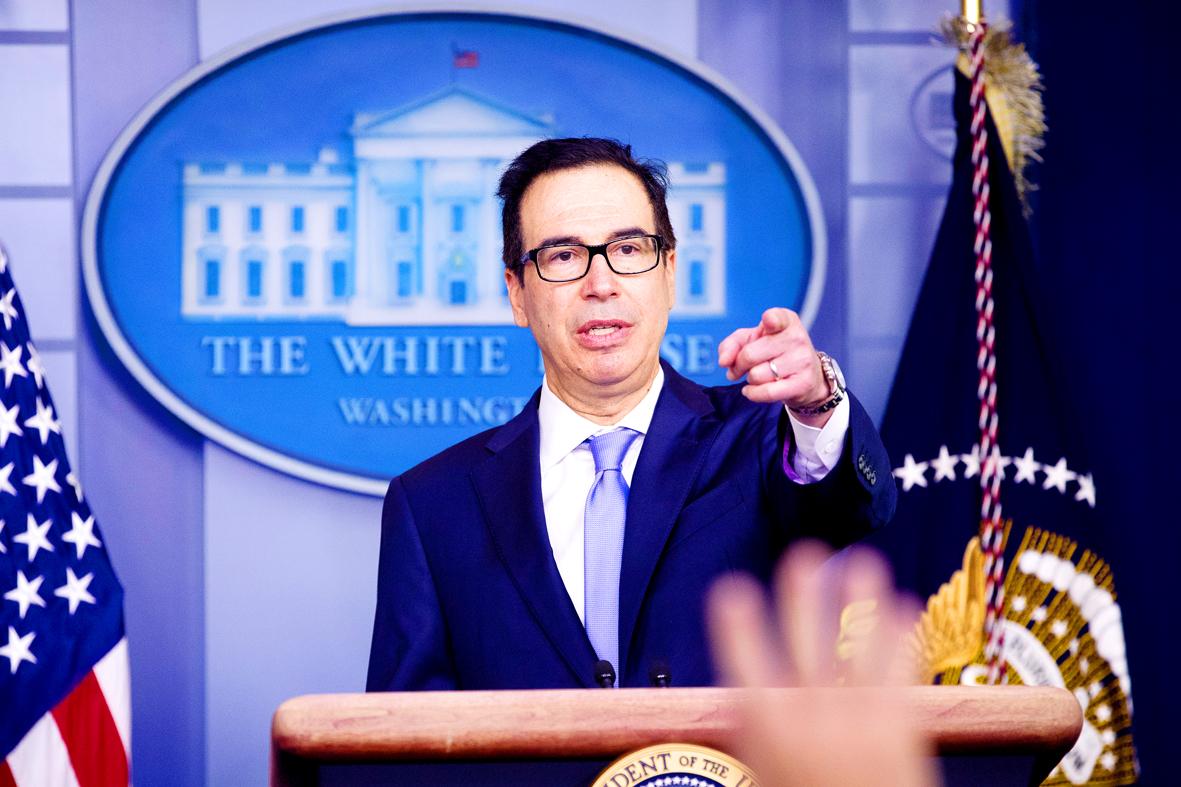The US Treasury on Thursday announced it had reached an agreement with five major airlines on the terms of loans to rescue their businesses after the COVID-19 pandemic badly dented air carriers.
The US$2.2 trillion Coronavirus Aid, Relief and Economic Security (CARES) Act stimulus package passed in late March provided for US$25 billion to be lent to the airline industry, but carriers were hesitant to take the money for fear of draconian conditions.
American Airlines Group Inc, Frontier Airlines Inc, Hawaiian Airlines Inc, SkyWest Airlines Inc and Spirit Airlines Inc finally agreed to the government’s terms, the treasury said in a statement.

Photo: Bloomberg
Discussions are continuing with other companies in the sector.
“We are pleased that major air carriers intend to use this important program and for treasury to use its authority under the CARES Act to provide much-needed financial assistance, while ensuring appropriate taxpayer compensation,” US Secretary of the Treasury Steven Mnuchin said.
The Treasury did not provide details of the loan terms, saying only that it required borrowers to provide warrants, which are financial instruments that can be converted into shares, or other forms of debt or equity.
Borrowers must also comply with conditions like maintaining employment and not paying employees above set levels, along with temporarily suspending the payment of dividends and share buybacks.
These loans are on top of another US$25 billion package paid out by the government in exchange for a commitment by the airlines not to cut jobs until after Sept. 30.
American Airlines on Thursday confirmed it had signed a letter of intent with the Treasury for a US$4.75 billion loan, and hoped to finalize the terms by the end of September.
However, CEO Doug Parker and president Robert Isom said in a letter the company expects to have 20,000 more employees than necessary by the fall.
“To be clear, this doesn’t mean 20,000 of our team members will be furloughed in October, it simply means we still have work to do to right-size our team for the airline we will operate,” they wrote.
“We continue to work with our union partners to find creative solutions that involve voluntary leaves and early-out programs,” they said.

Taiwan Transport and Storage Corp (TTS, 台灣通運倉儲) yesterday unveiled its first electric tractor unit — manufactured by Volvo Trucks — in a ceremony in Taipei, and said the unit would soon be used to transport cement produced by Taiwan Cement Corp (TCC, 台灣水泥). Both TTS and TCC belong to TCC International Holdings Ltd (台泥國際集團). With the electric tractor unit, the Taipei-based cement firm would become the first in Taiwan to use electric vehicles to transport construction materials. TTS chairman Koo Kung-yi (辜公怡), Volvo Trucks vice president of sales and marketing Johan Selven, TCC president Roman Cheng (程耀輝) and Taikoo Motors Group

Among the rows of vibrators, rubber torsos and leather harnesses at a Chinese sex toys exhibition in Shanghai this weekend, the beginnings of an artificial intelligence (AI)-driven shift in the industry quietly pulsed. China manufactures about 70 percent of the world’s sex toys, most of it the “hardware” on display at the fair — whether that be technicolor tentacled dildos or hyper-realistic personalized silicone dolls. Yet smart toys have been rising in popularity for some time. Many major European and US brands already offer tech-enhanced products that can enable long-distance love, monitor well-being and even bring people one step closer to

New apartments in Taiwan’s major cities are getting smaller, while old apartments are increasingly occupied by older people, many of whom live alone, government data showed. The phenomenon has to do with sharpening unaffordable property prices and an aging population, property brokers said. Apartments with one bedroom that are two years old or older have gained a noticeable presence in the nation’s six special municipalities as well as Hsinchu county and city in the past five years, Evertrust Rehouse Co (永慶房產集團) found, citing data from the government’s real-price transaction platform. In Taipei, apartments with one bedroom accounted for 19 percent of deals last

RECORD-BREAKING: TSMC’s net profit last quarter beat market expectations by expanding 8.9% and it was the best first-quarter profit in the chipmaker’s history Taiwan Semiconductor Manufacturing Co (TSMC, 台積電), which counts Nvidia Corp as a key customer, yesterday said that artificial intelligence (AI) server chip revenue is set to more than double this year from last year amid rising demand. The chipmaker expects the growth momentum to continue in the next five years with an annual compound growth rate of 50 percent, TSMC chief executive officer C.C. Wei (魏哲家) told investors yesterday. By 2028, AI chips’ contribution to revenue would climb to about 20 percent from a percentage in the low teens, Wei said. “Almost all the AI innovators are working with TSMC to address the